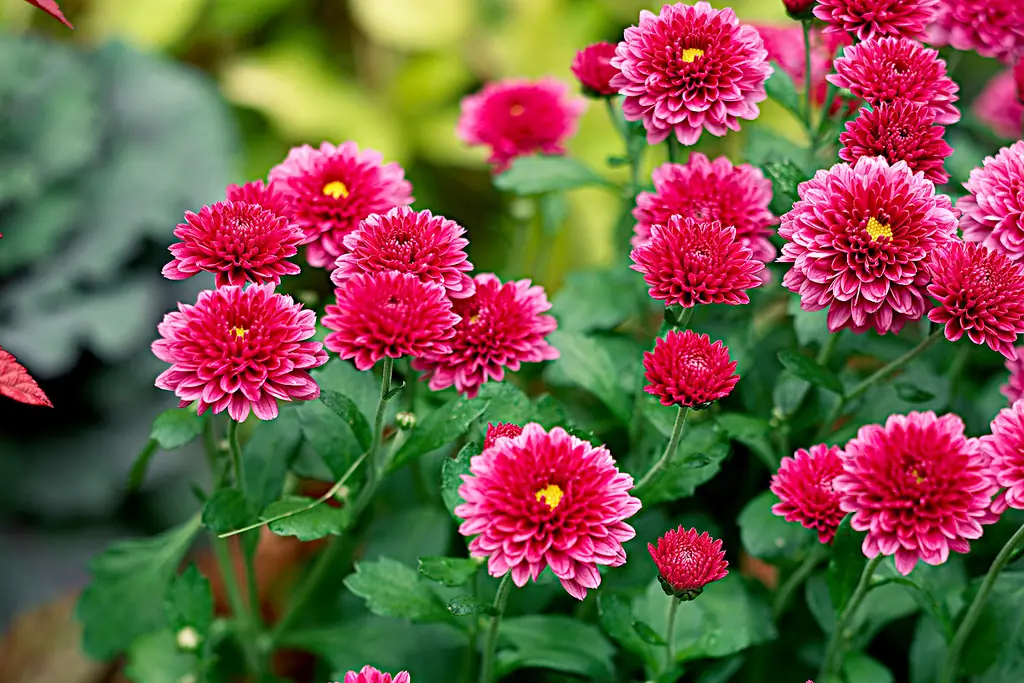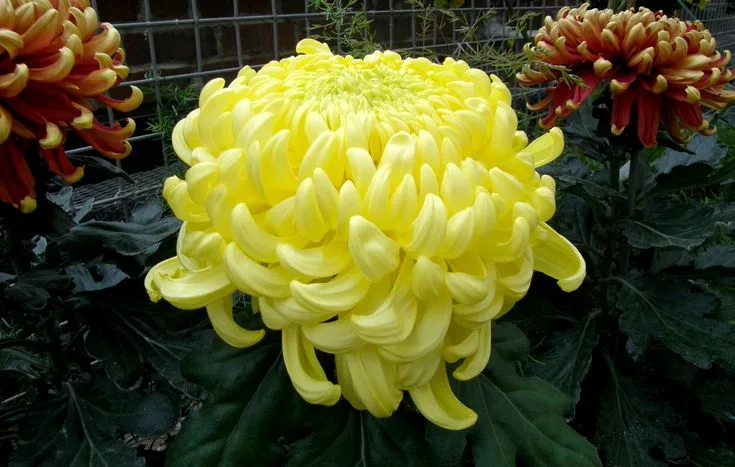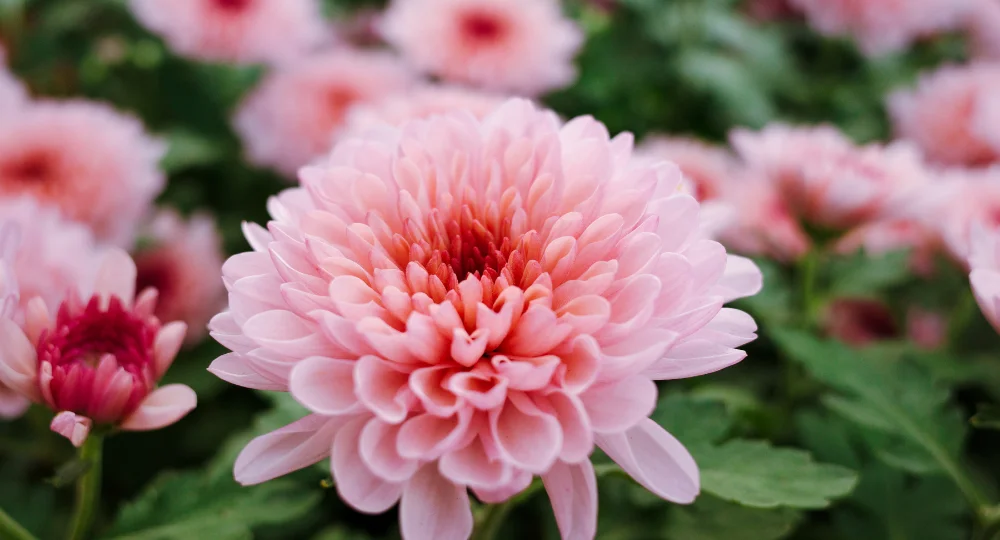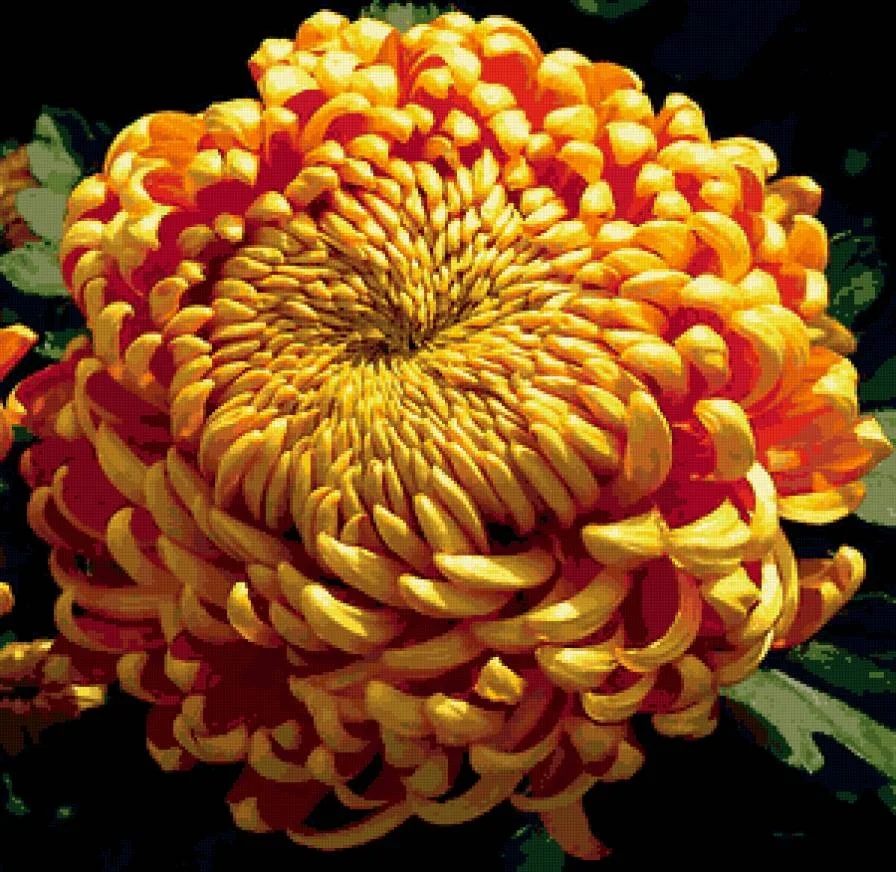Index
Introduction
Chrysanthemum Morifolium, popularly known as chrysanthemum, is an ornamental flower native to Asia, especially China and Japan. This plant belongs to the Asteraceae family and is widely cultivated throughout the world due to its beauty and diversity of colors. The chrysanthemum is one of the most popular flowers in floral arrangements and is often used at special events, such as weddings and funerals, as well as being appreciated in ornamental gardens for its resistance and longevity.
With its dense petals and variety of shapes and sizes, the chrysanthemum captivates the eyes of onlookers, providing a sense of serenity and beauty. Its wide range of colors, which includes vibrant shades of yellow, orange, pink, white and red, allows for a multitude of combinations in floral arrangements, making it a versatile choice for decoration and artistic expression.
Meaning of Chrysanthemum morifolium
The chrysanthemum has a rich symbolism in various cultures around the world. In Japanese culture, for example, it is associated with longevity and happiness and is often used as an imperial emblem. In China, it is a symbol of wisdom and friendship. In addition, in many other cultures, the chrysanthemum is considered a symbol of hope, renewal and admiration, conveying a positive and comforting message to those who receive it.
| Item | Information about Chrysanthemum morifolium |
|---|---|
| Common Name | Chrysanthemum |
| Botanical Name | Chrysanthemum Morifolium |
| Family | Asteraceae |
| Plant Type | Perennial |
| Adult Size | Variable, depending on the variety |
| Sun exposure | Full sun to half shade |
| Soil type | Well-drained, rich in organic matter |
| soil pH | Neutral to slightly acidic (pH 6.0-7.0) |
| Flowering time | Late summer to fall |
| Flower color | Yellow, orange, pink, white, red |
| Native Area | Asia, especially China and Japan |
| Toxicity | Generally non-toxic, but may cause skin irritation in some people |

How to care for Chrysanthemum morifolium
Proper care is essential to ensure that your Chrysanthemum morifolium blooms exuberantly and stays healthy over time. Here are some tips on how to care for this beautiful flower:
Light
Chrysanthemum morifolium thrives in places with direct to partial sunlight. Position the plant in a spot where it receives at least six hours of sunlight a day. If you’re growing Chrysanthemum morifolium indoors, make sure you place it near a window that gets plenty of sunlight.
Soil
The soil for Chrysanthemum morifolium should be well-drained and rich in organic matter. Use a potting soil mix that allows good drainage to avoid water accumulating around the roots. Adding organic compost to the soil will help provide the nutrients needed for the plant’s healthy growth.
Watering
Water Chrysanthemum morifolium regularly, keeping the soil slightly damp but avoiding waterlogging. The frequency of watering will depend on the environmental conditions and the type of soil, but it is generally recommended to water when the top of the soil begins to dry out. Avoid wetting the leaves to prevent the development of fungal diseases.
Temperature and humidity
Chrysanthemum morifolium prefers moderate temperatures and average relative humidity. Keep the plant at a temperature between 15°C and 21°C to encourage healthy growth and abundant flowering. If you are growing Chrysanthemum morifolium indoors, avoid placing it near draughts or heat sources that could dry out the air.
Fertilizing
Fertilize Chrysanthemum morifolium regularly during the growing season to promote vigorous flowering. Use a balanced fertilizer for flowering plants and follow the instructions on the label for proper application. Avoid over-fertilizing, as this can result in excessive leaf growth to the detriment of the flowers.

How to make Chrysanthemum morifolium seedlings
If you want to expand your Chrysanthemum morifolium garden, making cuttings is a great way to propagate this beautiful flower. Here are some instructions on how to make Chrysanthemum morifolium cuttings:
Propagation by Cuttings
1.Choose a healthy plant: Select a healthy and vigorous mother plant to take cuttings from. Make sure that the plant is not flowering at the time of propagation.
2. Cut the cuttings: With sharp pruning shears, cut approximately 10 to 15 centimeters long cuttings from new growth. Remove the lower leaves and leave just a few leaves at the top end of the cutting.
3. Prepare the substrate: Fill small containers with a light, well-drained substrate, such as a mixture of peat and perlite.
4. Plant the cuttings: Make a small hole in the substrate and insert the base of the cutting, making sure it is firmly planted. Keep the substrate slightly damp, but avoid waterlogging.
5. Keep the cuttings in a protected environment: Place the cuttings in a location with indirect light and a stable temperature. Keep the substrate moist and protect the cuttings from draughts.
6. Rooting and transplanting: After a few weeks, the cuttings will develop roots. Once the roots are well established, the cuttings can be transplanted into larger pots or directly into the garden.

How to plant Chrysanthemum morifolium
Now that you have your seedlings ready, it’s time to plant Chrysanthemum morifolium in the garden or in pots. Here are some tips on how to plant this stunning flower:
Choosing a location
Choose a sunny spot: Chrysanthemum morifolium prefers locations with direct to partial sunlight. Select a spot in the garden where the plant receives at least six hours of sunlight a day.
Preparing the soil
Prepare the soil: Make sure the soil is well-drained and enriched with organic matter. Dig the soil to a depth of about 20 centimeters and mix in organic compost to improve the soil structure.
Planting
Plant the seedlings: Dig a small hole in the soil and plant the Chrysanthemum morifolium seedlings, making sure the roots are well covered. Leave enough space between the plants to allow for good growth and air circulation.
Watering
Water deeply: After planting, water deeply to ensure that the roots of the seedlings are well saturated. Continue watering regularly, keeping the soil slightly damp but avoiding waterlogging.
Maintenance
Takecare of the plants: Remove wilted flowers regularly to encourage continuous flowering. Fertilize the plants every two weeks during the growing season with a balanced fertilizer for flowering plants.
With these simple tips, you’ll be ready to enjoy the beautiful flowers of Chrysanthemum morifolium in your garden or in pots in no time.
Most common pests and diseases
When growing Chrysanthemum morifolium, it’s important to be aware of the pests and diseases that can affect this plant. Here is a list of the most common ones:
- Mites: Small insects that feed on the leaves, causing yellowing and deformation.
- Aphids: Sucking insects that can cause leaf deformation and stunt the plant’s growth.
- Powdery mildew: A fungus that manifests itself as a white powder on the leaves, causing the plant to weaken.
- Root rot: Caused by excess moisture in the soil, resulting in waterlogged and rotten roots.
- Mildew: A fungus that causes yellow spots on the leaves and can lead to premature leaf fall.
- Botrytis: A fungus that causes necrotic spots on leaves and flowers, leading to deterioration of the plant.

Common Problems and Their Solutions
Pest Control
1.Washing the leaves: Use a jet of water to wash the leaves and remove the mites and aphids. Repeat the process regularly to control the infestation.
2. Natural Insecticides: Apply natural insecticides such as potassium soap or neem oil to control aphid infestations.
Treatment of Fungal Diseases
1. Removing Affected Leaves: Remove leaves affected by powdery mildew or downy mildew to prevent the spread of the disease. Dispose of the removed leaves in a place away from the garden.
2. Fungicides: Apply specific fungicides to treat powdery mildew and downy mildew, following the instructions on the label for an effective application.
Preventing soil problems
1. Adequate drainage: Make sure the soil has good drainage to prevent root rot. Avoid overwatering and grow Chrysanthemum morifolium in a location with well-drained soil.
2. Crop rotation: Practice crop rotation to avoid the accumulation of pathogens in the soil. Do not plant Chrysanthemum morifolium in the same place for several consecutive seasons.
With these control and prevention measures, you can keep your Chrysanthemum morifolium healthy and protected against the most common pests and diseases.
Curiosities and myths
Chrysanthemum morifolium, in addition to its beauty and importance as an ornamental plant, is surrounded by various curiosities and myths. Let’s explore some of them:
Origin of the Name
1. Meaning of the Name: The name “Chrysanthemum” derives from the Greek words “chrysos” (gold) and “anthemon” (flower), reflecting the wide range of golden colors of this plant’s flowers.
Cultural Symbolism
2. Symbol of Honor: In Japan, Chrysanthemum morifolium is a national symbol and is associated with the imperial family, often being used as an emblem on coats of arms and insignia.
3. Festive flowers: In China, the chrysanthemum is traditionally associated with the autumn period and is celebrated during the Chrysanthemum Festival, where people display colorful varieties of the flower.
Longevity Myth
4. Belief in Longevity: In some Asian cultures, it is believed that drinking chrysanthemum tea can promote longevity and health and is used as a medicinal drink.
Varieties and cultivation
5. Exotic Varieties: There are thousands of varieties of Chrysanthemum morifolium, each with its own unique characteristics of color, shape and flower size.
6. Annual or Perennial Cultivation: Although many people consider the chrysanthemum to be an annual plant, some varieties are perennial and can return year after year with proper care.
Popular Myths
7. Insect repellent: There is a popular belief that the smell of chrysanthemum leaves is an insect repellent and is used as a natural means of pest control in gardens.
8. Lunar Influence: In some cultures, there is a belief that the chrysanthemum blooms according to the phases of the moon, being more likely to bloom during the full moon.
While some of these curiosities may have solid scientific bases, others are more folklore. However, they all contribute to the cultural richness and fascination surrounding Chrysanthemum morifolium.

Conclusion
In short, Chrysanthemum morifolium is much more than just an ornamental flower. Its deep cultural origins, its symbolism rooted in various civilizations and its many varieties and associated myths highlight its importance beyond the aesthetic aspect. It is a plant that inspires honor, longevity and beauty, permeating festivals, ceremonies and traditions around the world. Its cultivation requires specific care, from the choice of soil to pest and disease control, but the efforts are rewarded with a profusion of dazzling flowers that brighten gardens and lift spirits.
By learning about the curiosities and myths surrounding Chrysanthemum morifolium, we are invited to immerse ourselves in a universe rich in history, tradition and cultural wisdom. Its relationship with nature, its influence on celebrations and its presence in mythology offer a fascinating perspective on how plants can transcend their botanical role and become central elements in the tapestry of human life. So, by admiring this beautiful flower, we also honor the ancient traditions and cultural richness it represents.
Frequently Asked Questions
What is the chrysanthemum flower good for?
The chrysanthemum flower, also known as Chrysanthemum morifolium, serves mainly as an ornamental plant, used to decorate gardens, floral arrangements and special events such as weddings and funerals. In addition, in some Asian cultures, its petals are used to make tea, with therapeutic and medicinal properties.
What does the chrysanthemum flower mean?
The meaning of the chrysanthemum flower varies according to different cultures around the world. In Japan, for example, it is associated with longevity, happiness and the emperor, and is considered a national symbol. In China, it represents wisdom, friendship and honesty. In general, the chrysanthemum is often related to positivity, renewal and admiration.
How to care for Chrysanthemum Morifolium?
To care for Chrysanthemum Morifolium, it is essential to provide it with adequate sunlight, regular watering, well-drained soil and balanced fertilization during the growing season. In addition, it is important to pay attention to pest and disease control, removing wilted flowers and damaged leaves to promote healthy, long-lasting flowering.







